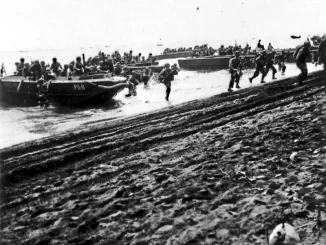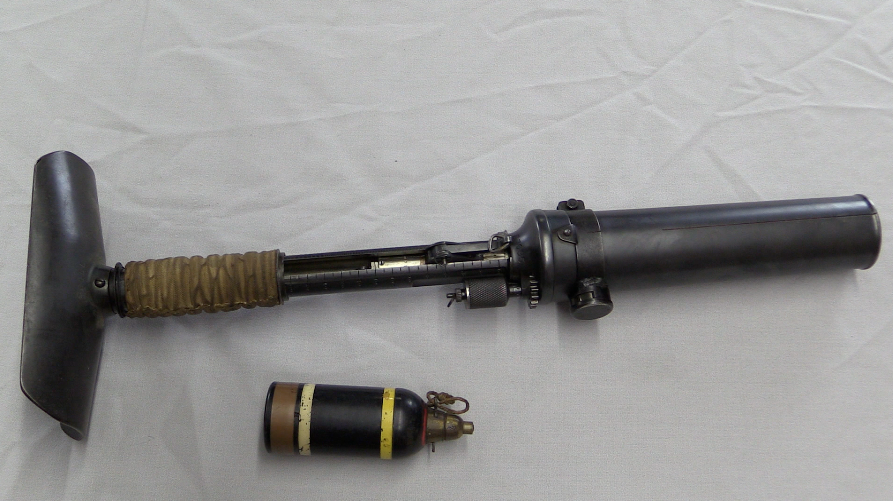The Japanese military made the decision to move from a 6.5mm infantry rifle to a more powerful 7.7mm cartridge in the 1930s, with specifications for the new rifle proposed in 1938. In response, the Nagoya and Kokura Arsenals developed new models of rifle and carbine.
What we are looking at today is one of the Nagoya (Plan #1) experimental carbines; serial number 4 to be specific. It has a variety of novel features, including:
Spring loaded buttplate for recoil reduction
Unique muzzle brake
New aperture rear sight
Threaded cleaning rod
New magazine retention system
Recoil bolt in stock
These carbine, and the other experimental patterns, were tested at the Futsu Proving Ground in 1939. Elements of both designs were ultimately used to create the Type 99 adopted later in 1939 (Japanese calendar year 2599).




So the spring-loaded buttplate of the HiPoint carbines isn’t unique?
“(…)spring-loaded buttplate(…)”
For other example see https://guns.fandom.com/wiki/Gana-Krnka_M1876
To counteract the recoil, it features(…)spring in the butt plate.
Wow!
What a cool discovery
Amazing that it survived so well, and didn’t get bubba’d.
With the benefit of hindsight, I can understand the objections to that muzzle brake (ouch!)
A cone like a No5 Lee Enfield might have been more appropriate. Imagine firing that with no ear protection or even worse being beside it.
Is the finish of the replacement bolt representative? It looks out of place compared to the rest of the rifle.
Also
Is that an actual seperate band applied to the receiver ring? Or is it simply a monolithic part of the receiver?
As this rifle is something of a ‘bitsa,’ comprised of a T38 receiver and a 7.7x58mm barrel, it uses a standard T38 bolt with the slight modification of the bolt handle. The standard finish for an early T38 bolt is ‘in the white,’ along with the safety knob, with the bolt handle shaft blued. Later guns had blued safety knobs.
I suspect that the ‘band’ on the receiver is an added part, as there would be no need to machine an entirely new receiver when hundreds of thousands of T38s already existed. It is probably shrunk on, serving the same purpose as the band on a Parrott rifled gun, to strengthen that area of the receiver due to the added pressure of the 7.7x58mm cartridge–although it is clearly not necessary, as the T38 receiver is immensely strong.
Just for fun, Gen. Arisaka had been dead for some 20 years when this rifle was made. He WAS responsible for the design of the first 6.5mm rifles in Japanese service, the T30 of 1897 (which wasn’t very good), but his only contribution past that was to be the figurehead on development committees. The man MOST responsible for the T38 of 1905 was actually a fellow named ‘NAMBU.’ Kijiro Nambu, actually. HE was the designer of the T38, the T99, the T14 and T94 pistols, and virtually every other Japanese military small arm including the T11, T96, and T99 machine guns. Nambu died in 1949.
I know it’s not going to change anything, but ALL of the Japanese military rifles that followed the T30 are NOT ‘Arisakas,’ but are actually ‘Nambus.’
Thanks
The finishing of the bolt did look a bit rough compared to the other parts
I was forgetting that type 38 and type 99 bolts are slightly different lengths and won’t fit in the other rifle.
Interesting. Why they scraped their almost perfect 6.5mm round makes little sense. The sights on that carbine appear to be both fast and durable. Japan could have converted existing Type 38s into short rifles, with the new rear sights, and had the best bolt-actions of WWII. Basically an East-Asian Swedish Mauser.
Gotta wonder how much influence the usual suspects had with the Japanese military when it came to critiquing the 6.5. Were they paying attention to American gun writers, or had they developed opinions of their own based on practical experience in China?
It is truly disturbing, sometimes, how much military policy and procurement is influenced by faddishness and groupthink. “Oh, the 5.56mm is inadequate…” followed by some idiots recapping the failed 7.62 NATO process and coming out with the .276 Pedersen…
I still haven’t seen anything I’d consider as logical and definitive to justify that whole cluster-fark. It’s all hidden behind classification, and I’d be willing to lay long odds that there’s really Jack and Sh*t actually there, in terms of actual data and real logic. “Overmatch”. Yeah, right… Sure, you’ll have “overmatch”, and along with it you’re going to get “excessive recoil”, “uncontrollable on full-auto”, “rapid barrel wear-out”, and “too expensive to actually field”.
No doubt all the documentation was burned before the Tokyo Bay surrenders. Or, simply not preserved by the Occupation authorities because they didn’t see the value of it all.
Apparently, while 6.5X50 semi-rim Arisaka is lethal enough, it is not INSTANTLY lethal. Any sufficiently frenzied attacker might not notice that he’s run out of blood until after he axes you to leave this mortal coil (unless you got the entire platoon to shoot him right in the face). So, the choices for small arms development are as follows:
1. Develop a self-loading rifle to increase rate of fire, even without changing the cartridge
2. Develop a much “punchier” cartridge, even if you’re still using a bolt-action rifle
3. Bunch your riflemen around machine gunners and increase the number of machine guns per infantry company
Which choice costs the least amount of material? Remember, Imperial Japan is SHORT on high-quality iron ore and cartridge brass…
“Develop a self-loading rifle to increase rate of fire, even without changing the cartridge”
They tried that and they failed, see https://augfc.tumblr.com/post/686870827348738048/japans-type-k%C5%8D-rifle-in-testing-in-the-early
The main motivation was twofold, and both parts were the result of China.
Part one was that while the 6.5 x 50SR Arisaka was a perfectly adequate rifle round in the man-killing department, it wasn’t quite powerful enough to suit the Army as a heavy machine gun round. It didn’t have enough reach or enough penetration for that job.
Part two was that both the Japanese Army Air Force and the Imperial Naval Air Service wanted a more powerful round for the machine guns on their aircraft. Again, 6.5 x 50SR wasn’t hard-hitting enough for the job.
The other option was sticking with the old 8 x 53Rmm Murata 1888, with improved propellants and a boattail, spire-point bullet, but the Army Air Force didn’t think much of a rimmed round in a belt-fed MG.
The final decision was to go with a completely new cartridge, the 7.7 x 58mm Arisaka, which looked suspiciously like a slightly-revised 7.9 x 57mm Mauser. (The Japanese forces had encountered that one in China.) It was adopted as the standard Army HMG and aircraft MG round in 1938.
And naturally, they decided that a new rifle to fire it should replace the “Meiji 38” in 6.5 x 50SR.
The Japanese Army ended up in the same fix as the Italian Army, which decided to do a similar changeover from 6.5 x 52mm Carcano to 7.35 x 51mm Carcano about the same time. Each army ended up with rifles and MGs in both calibers, complicating the logistics situation.
A better solution of course would have been for the IJA to have just standardized the 7.7 x 51mm as the new machine gun round and left the infantry with the 6.5 x 50SR rifles.
As for the IJN, they ended up in the same “boat”, with the addition of their own 7.7 x 56Rmm machine gun round- otherwise known as their copy of the 0.303 inch Enfield rifle round used in a copy of the Lewis LMG used as both a ground gun and an aircraft flexible gun.
Incidentally, the Italians really needn’t have bothered, as they already had a perfectly adequate, very modern heavy MG round, the 8 x 59mm Breda. There was never a rifle made for it, with good reason, as it had roughly the ballistics of the British .300 Holland & Holland big game round.
And recoil to match.
cheers
eon
“(…)8 x 59mm Breda. There was never a rifle made for it(…)”
False, Pavesi 1942 did existed, c.f. photographic evidence
https://www.forgottenweapons.com/pavesi-model-1942-prototype-semiauto-video/
A rare rabbit indeed to catch and cool to see. Speaking of, and just to be a grammar nerd, one can catch a rare rabbit by “unique-ing up on it” but nothing is “very or somewhat “unique” strictly speaking it is a binary condition. Unique may apply to this carbine as it appears to be the only known example. “Somewhat unique” is an oxymoron.
Not to be pedantic, but prescriptive grammar is bunk. Language is what people speak and write, not what prescriptivists harangue native speakers over. 99% of the population understand degrees of uniqueness very well, thank you.
And the other 1% speak properly.
The 13th Analect of Confucius refutes what you’re saying:
13.3 Zilu said, “If the ruler of Wei were to entrust you with governance of his state, what would be your first priority?”
The Master said, “Most certainly, it would be to rectify names.”
Zilu said, “Is that so? How strange of you! How would this set things right?”
The Master said, “What a boor you are, Yóu! A junzi keeps silent about things
he doesn’t understand.”
“If names are not right then speech does not accord with things; if speech is not
in accord with things, then affairs cannot be successful; when affairs are not successful, li and music do not flourish; when li and music do not flourish, then sanctions and punishments miss their mark; when sanctions and punishments miss their mark, the people have no place to set their hands and feet.”
“Therefore, when a junzi gives things names, they may be properly spoken of, and
what is said may be properly enacted. With regard to speech, the junzi permits no carelessness.”
To paraphrase, sloppy and imprecise language gives rise to sloppy and imprecise thought, which then leads to ill-considered and erroneous action. In this passage of his analects, 13.3 stresses the need to align names to reflect the reality of circumstances. You cannot discuss issues without accurately and forthrightly describing them, and if you do, your response to that set of circumstances will be warped out of alignment with your intent and purpose. You will address the wrong issues, or the wrong aspects of those issues, simply because you failed to use the proper language to describe them.
An example would be to describe a woman’s death as being the result of “an assault”, leaving out that it was actually because of a brutal murder. Fundamentally erroneous terminology leads to the malefactor in this case being adjudged for the commission of a misdemeanor rather than felony murder. False and inadequate terminology and imprecise language lead to false and erroneous judicial outcomes, just as they do everywhere else we apply language.
We should keep in mind that, according to the standard work on WW2 wound ballistics by Beyer, surgeons usually could not tell a 7.7 mm wound from a 6.5 mm wound. I agree with Kirk that opinions tend to outweigh facts in this field.
The very little that I have read on the subject, is in agreement.
There seems to be a wide variation in wounding depending upon the exact details of the hit and the path of the bullet, and also on the state of the recipient;
Were muscles tensed as they ran or man handled heavy equipment, or relaxed as he sat with his back against a tree, enjoying a smoke. Bladder full or empty…
That hit to hit variation appears to outweigh the variation between military rifle calibres from the first half of the twentieth century.
6.5 remains a popular Scandinavian calibre for their Elk (Moose), and both 6.5×54 Mannlicher Schoenauer and 6.5x53R Mannlicher were both extremely popular in Africa and were used for all game in open conditions. 7x57mm, even more so.
Getting back to supposed “trials”, and accepting that pistol bullets at 1100fps are very different in wounding effect to rifle bullets at >2200 fps
The shooting of cattle in a slaughter yard to determine what calibre a new American pistol should be…
Did turn up one interesting result;
The only instant knockdown and kill with a single chest shot, was achieved with a 7.65mm Luger.
None of the records of that cruel playing around present anything to support the conclusion that was drawn, that. 45 was the minimum calibre suitable.
8:52 The gases will not be able to push the rifle forwards to counter the recoil, because rifle and break are technically the same body. This is the same reason why you are not able to lift yourself up in the air by bulling your hair upwards with your own arm. The shield is most likely there to prevent the gases from escaping forwards and therefore reducing the rocket effect.
Hey Ian, I just happened to find this article and it reminded me of a strange Type-99 Arisaka I recently purchased. The only marking on the rifle are the proof marks, serial number and series mark, and factory mark. The last marking on the gun is the most bewildering of all, the chrysanthemum and type marks have been removed and the area refinished replacing them are the markings “USBM” with “TEST” under it.
My first thought was US Ballistics Manual but after a bit of googling I found no such thing. The only was the Bureau of Mines (USBM) but it makes zero since why they would have a type 99 Arisaka or why it would be stamped “TEST”. The rifle is chambered in 7.7 Arisaka and has not been rebored.
What I do know about the rifle is as fallows:
Type 99
Kokura Arsenal production
1935-1945
Series 21
SN: 84000 range
Marking on top of the receiver: USBM TEST
Chrysanthemum and type markings removed.
If you like I can send you pictures of the rifle.